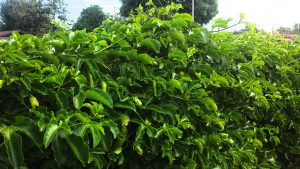Passionate about Passionfruit
The passionfruit vine is not a hard vine to grow but many people tell me they struggle trying to get them to thrive and many questions start popping up about what they may be doing wrong.
We love our passionfruit but how do we make them a successful fruiting vine?
The important thing to remember about passionfruit is that it loves the warmth, having originated in South Brazil. It is a vine so something to grow on like trellis or wire will be needed.
For those that have been considering growing passionfruit but never have, give it a go. If it is in the right spot it will flourish and not only does it give amazing fruit that can be eaten fresh or made into sauces or spreads but it has the most unique and stunning flowers. The first time I saw one of the blooms I couldn’t believe it was the flower from a passionfruit vine.
New planting guide:
When to plant:
The best time to plant a passionfruit plant is in mid to late spring when any chance of frost has passed and the soil temperatures are really starting to warm up, you can plant up until late summer.
Where to plant:
Passionfruit thrive in a warm and sunny position. A frost free position free from strong winds is best. A sunny but sheltered place is ideal. The vines can grow on a trellis, on a wall or a fence. Affix wires that it can attach itself to. They can be grown over an archway or a pergola and even grown in wide and large pots so they have room to grow. Half wine barrels are a good option. Place the pot up against the wall or create a suitable climbing frame.
How to plant:
Make sure the soil is nutrient rich before planting. Add compost and manure to the soil. Passionfruit will thrive with lots of nutrients, after all it has big glossy leaves and big fruit to produce so the nutrients are super important. Good drainage is also a must as passionfruit doesn’t like wet feet. Adding compost or gypsum may help break up any clay soils. Planting in a raised bed may aid in helping excess water drain away. Mulch around the bottom of the plant to keep the roots cool and the moisture locked in.
Passionfruit care guide for existing vines:
Pruning:
One of the most common questions people ask is when they should prune a passionfruit or even if they should prune their passionfruit?
The best time to prune is in spring when the chance of frost is minimal. Passionfruit produce on current season’s growth meaning that you won’t be cutting off any potential fruiting limbs by accident. Pruning in spring can encourage new growth, giving you more fruit. It also helps the air flow, reducing chance of getting any fungal diseases. It is a great way to keep the vine to the height and shape you want and getting rid of any untidy branches.
You do not have to prune your passionfruit if you would prefer not to but it does make harvesting easier and will help with managing the vine as they are such a fast growing plant.
- Cut off any dead, dying or diseased branches- anything that is looking unsightly.
- Take out any weak branches, overcrowded or dense branches.
- Cut off branches that have a mind of their own and are growing where you don’t want them.
- You can reduce the vine up to a third to maintain the height.
Watering and Feeding:
Passionfruit do require a good drink, especially in pots where they dry out easily. Water more often in summer and when fruit begins to set and then ripen, at least 3 times a week. They need a lot of moisture around this time.
Passionfruit is a very hungry plant in the growing season. Having sheep pellets and compost around your plant is going to be beneficial.
I also use citrus fertiliser to boost my fruit production as it is high in potassium.
Harvesting:
Fruit can ripen from around February to June. The skin will turn to dark purple and can shrivel slightly. Cut them from the vine or they will be ready when they have dropped to the ground. The fruits will continue to ripen after they are picked.
Pests and Disease: Doing the above things to maintain your vine will reduce any risk of pests and disease, but some of these common problems may occur:
Passionvine hopper: Small moths are crowding the plant. These can be sprayed with Yates Mavrik or Yates Nature’s Way
Scale & aphids: Leaves can be sticky, a noticeable infection of aphids may be present or you have a dark sooty mould covering the plant. These little critters might be sucking all the sap from your plants. Spray with an insect spray. I like to go with an oil based insect control or Mavrik.
Slugs and snails: Holes in leaves or eaten leaves can be a common passionfruit problem. Be careful when planting new plants. Quash snail and slug pellets are the best to use if you have children and pets around the home.
Fungal diseases: Brown spots on leaves is just one type of fungal disease you may get. Spraying with copper can eliminate this problem. Be sure to get the air movement by pruning and make sure drainage is adequate.
Root rot: This can happen when the plant is sitting in too much water. You will need to fix the drainage problems. Try adding compost, planting in a different spot or a planting bit higher.

